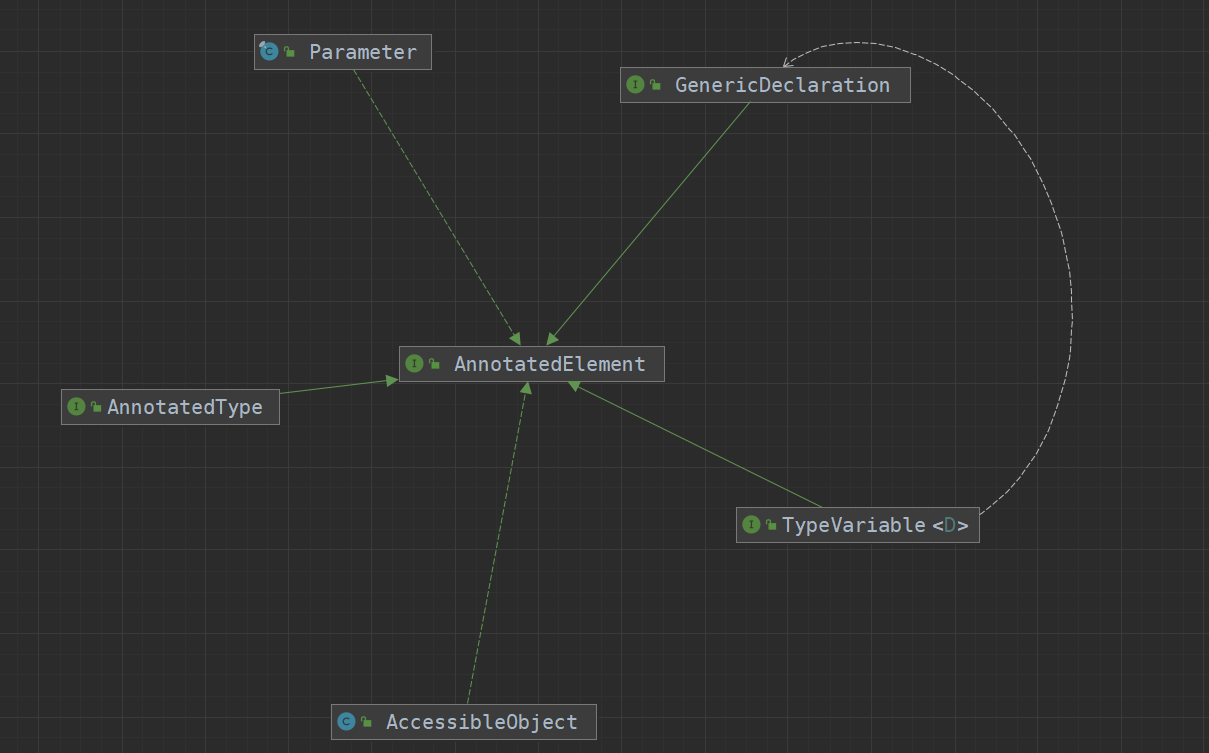AnnotatedElement
1、元素与注解的四种关系
- 直接存在(directly present)
直接存在或者直接引用。当一个注解直接在元素上引用时,则为直接引用,比如下面代码,
@Configuration就是直接引用在类FilterConfig上

- 间接存在(indirectly present)
间接存在或间接引用。当一个注解A并没有注解引用在一个类E上,但是包含这个注解A的注解B被E直接引用了,这属于E对A的间接引用。
@Component就是间接引用在类FilterConfig上

- 存在(present)
存在或引用。有直接存在间接存在着两种情况的都属于存在类型,
1、注解A直接存在或者间接存在元素E上,则A存在元素E上
2、注解A(用@Inherited标识注解)直接引用于E类的超类F,那么E与A的关系则为引用关系,@Configuration存在类XssFilterConfig

- 关联(associated)
1、直接引用关系
2、间接引用关系
3、引用关系
4、一个注解A(用@Inherited标识注解)与E类的超类F相关联,那么E与A的关系也为关联关系
2、AnnotatedElement方法跟关联关系对应表
| 方法名称 | 直接存在 | 间接存在 | 存在 | 关联 |
|---|---|---|---|---|
| T getAnnotation(Class<T>) | √ | |||
| Annotation[] getAnnotations() | √ | |||
| T[] getAnnotationsByType(Class<T>) | √ | |||
| T getDeclaredAnnotation(Class<T>) | √ | |||
| Annotation[] getDeclaredAnnotations() | √ | |||
| T[] getDeclaredAnnotationsByType(Class<T>) | √ | √ |
3、AnnotatedElement(接口)
3.1 AnnotatedElement类图
直接一级子接口 AnnotatedType、GenericDeclaration、TypeVariable
直接实现一级实现子类 Parameter、AccessibleObject

- 方法
// 判断元素上是否存在某类型注解(存在)
default boolean isAnnotationPresent(Class<? extends Annotation> annotationClass)
// 获取元素上某类型的注解(存在)
<T extends Annotation> T getAnnotation(Class<T> annotationClass);
// 获取元素上的所有的注解,返回数组(存在)
Annotation[] getAnnotations();
// 获取元素上指定类型的注解(关联)
default <T extends Annotation> T[] getAnnotationsByType(Class<T> annotationClass)
// 获取元素上指定类型的注解(直接存在)
default <T extends Annotation> T getDeclaredAnnotation(Class<T> annotationClass)
// 获取元素上直接存在的注解(直接存在)
Annotation[] getDeclaredAnnotations();
// 获取元素指定类型的注解(直接存在、间接存在)
default <T extends Annotation> T[] getDeclaredAnnotationsByType(Class<T> annotationClass)
Demo
import java.lang.annotation.*;
@Inherited
@Target(ElementType.TYPE)
@Retention(RetentionPolicy.RUNTIME)
@SuppressWarnings("all")
public @interface Action {
String value();
}
import java.lang.annotation.ElementType;
import java.lang.annotation.Retention;
import java.lang.annotation.RetentionPolicy;
import java.lang.annotation.Target;
@Target(ElementType.TYPE)
@Retention(RetentionPolicy.RUNTIME)
@SuppressWarnings("all")
public @interface Gender {
String type();
}
import java.lang.annotation.*;
@Repeatable(value = Hobbys.class)
@SuppressWarnings("all")
public @interface Hobby {
String value();
}
import java.lang.annotation.ElementType;
import java.lang.annotation.Retention;
import java.lang.annotation.RetentionPolicy;
import java.lang.annotation.Target;
@Target(ElementType.TYPE)
@Retention(RetentionPolicy.RUNTIME)
@SuppressWarnings("all")
public @interface Hobbys {
Hobby[] value();
}
@Identity(value = "造物者")
@SuppressWarnings("all")
public class Nuwa {
}
@Action(value = "行走")
@SuppressWarnings("all")
public class Human extends Nuwa{
}
@Hobby(value = "篮球")
@Hobby(value = "台球")
@Gender(type = "女")
public class People extends Human {
}
public static void main(String[] args) {
// 获取注解数组(只获取直接引用到类上的注解),
getDeclaredAnnotations(People.class);
// 获取引用关系的注解数组,@Action、@Identity注解与People为引用关系
getAnnotations(People.class);
// 通过类型获取注解,Hobbys注解与People为间接引用关系
getAnnotationByType(People.class, Hobbys.class);
// 通过类型获取注解,@Identity与People为关联关系
getAnnotationByType(People.class, Identity.class);
}
/**
* 获取callObj元素上<em>directly present</em>关系注解的数组
*
* @param callObj 被测试的元素
*/
private static void getDeclaredAnnotations(Class<?> callObj) {
System.out.println("---------------getDeclaredAnnotations----------------");
Annotation[] annotations = callObj.getDeclaredAnnotations();
for (Annotation annotation : annotations) {
System.out.println(annotation.annotationType().getName());
}
System.out.println();
}
/**t</em>关系注
* 获取callObj元素上<em>presen解的数组
*
* @param callObj 被测试的元素
*/
private static void getAnnotations(Class<?> callObj) {
System.out.println("---------------getAnnotations----------------");
Annotation[] annotations = callObj.getAnnotations();
for (Annotation annotation : annotations) {
System.out.println(annotation.annotationType().getName());
}
System.out.println();
}
/**
* 获取callObj元素上<em>associated</em>关系注解的数组
*
* @param callObj 被测试的元素
* @param queryAnnotation 要被查询的注解
*/
private static void getAnnotationByType(Class<?> callObj, Class<? extends Annotation> queryAnnotation) {
System.out.println("---------------getAnnotationByType----------------");
Annotation[] annotations = callObj.getAnnotationsByType(queryAnnotation);
for (Annotation annotation : annotations) {
System.out.println(annotation.annotationType().getName());
}
System.out.println();
}





 浙公网安备 33010602011771号
浙公网安备 33010602011771号